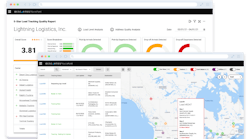The way the business world views the issue of “employee wellness” is changing radically these days, especially where the trucking industry is concerned. Rose Stanley, senior practice leader for the nonprofit human resources association WorldAtWork, explains that it is becoming a much broader issue than the traditional focus on the physical health of workers.
“When we say traditional, we mean programs that focus exclusively on employee physical health,” she says. “That’s an important aspect of health and wellness efforts, but today you’ve got to go above and beyond that. You need to move to a truly holistic view, which includes things like work/life balance issues and financial well-being such as dealing with debt, mortgages, and retirement. A person is more than just their physical health.”
Those kinds of issues create stress for employees, which is now the number-one workplace wellness issue worldwide.
“And stress affects everything from physical to mental health, productivity, absenteeism, etc.,” she points out. “Particular to trucking, stress relates to fatigue.”
Stephanie Klang, a 25-year veteran long-haul driver who’s logged 3 million safe driving miles with Con-way Truckload, understands how all of those issues intersect very well.
On the road 285 days a year, Klang says the key to staying healthy “in mind, body, and spirit” as she likes to describe it, is focusing on what a driver can and cannot control.
“You can’t control the weather, the traffic, the load, or delays at the dock,” Klang explains. “You can control what you eat, your ‘living area’ on the road, and use of downtime for exercise.”
For starters, she almost always prepares her own meals on the road, shopping at grocery stores as needed, which offers an added benefit of saving money.
“Drinking water while avoiding sodas plus other caffeinated and carbonated beverages is really important,” Klang adds, noting that removing stimulants such as sugar and caffeine from her diet helps promote more regular and restful sleep cycles.
Klang also exercises at every opportunity, using two five-pound dumbbells with an eight-pound weight ball to help keep her muscles in shape, while getting outside and walking whenever she can.
“You need to see the positive in ‘being stuck’ as I like to say,” she explains. “Use downtime at loading and unloading points or truck stops as chances to get out and walk, even if it’s just around the tractor-trailer.
“We sit too much as truck drivers; that’s why getting ‘out of the box’ and outside is important—not just physically but mentally as well,” Klang notes.
Health = safety
Gretchen Jackson, recruitment manager for Con-way Truckload, says it’s this type of inclusive approach to health that her company tries to support as a way to improve the well-being of the carrier’s drivers and also because it can boost safety and retention rates.
“To us, a healthier driver is a safer driver. They are less fatigued, more alert, and less prone to injuring themselves,” she explains. “That’s the ROI (return on investment) we work from when we talk about driver health.”
But almost more importantly, Jackson says Con-way Truckload wants to use this focus on health as another way to show that the driver is “not just a number” within the company.
“We do ‘Biggest Loser’-style contests periodically as a way to offer incentives for drivers to become and stay healthier,” she stresses. “That is part of our effort to get buy in not just from the driver but from their families as well. We want them to be as healthy as possible so they’ll have a long career with us.”
Rebecca Brewster, president and COO of the American Transportation Research Institute (ATRI), says the changing fleet mind-set is one reason the issue of driver health is getting more attention these days.
“Within an annual industry survey of top 10 fleet issues, driver health made its third appearance last year—ranked eighth among fleet issues and sixth among drivers,” she notes.
“There is a definite connection between the driver shortage and retention with health and wellness,” Brewster adds. “Yet, at the end of the day, it’s up to the individual to make the decisions. But what the industry can do is provide the opportunity for drivers to make and maintain health improvements.”
"They sit down and first figure out the specific challenges to eating better on the road and getting exercise within their particular operation, then figure out what programs might be most useful. It’s like ‘Weight Watchers’ in a way: You tailor the program to your personal situation."
—Rebecca Brewster, president and COO of the American Transportation Research Institute
She also points out that there’s much more awareness regarding driver health these days. “We are so much farther along than in the 1990s,” Brewster emphasizes. “Back then, only federal research programs were examining this issue. Now carriers are adopting health and wellness programs on their own left and right.”
ATRI sees motor carriers attaining the most success with driver health and wellness initiatives when a fleet develops such programs in collaboration with its drivers.
“They sit down and first figure out the specific challenges to eating better on the road and getting exercise within their particular operation, then figure out what programs might be most useful,” Brewster explains. “It’s like ‘Weight Watchers’ in a way: You tailor the program to your personal situation.”
She stresses, too, that there’s no point investing in a program if the drivers will not take advantage of it.
“That’s why you need to engage drivers from the start,” Brewster emphasizes. “Also, this doesn’t stop when they leave the truck and go home to their families. This has to be an entire family undertaking. There needs to be a training module for the family as well.”
There’s also a realization within the industry that “you just can’t put a treadmill in a truck” and expect the driver to become healthy overnight.
“It’s not just a one-solution type of issue; it’s about food, exercise, and education about health,” Brewster points out. “It’s about carriers providing options like exercise equipment in the cab and engaging the family. It’s a long-term effort and the need to commit to lifestyle changes. And it’s a pretty significant change in both the workplace and at home for drivers. That’s why you have to package it as a lifestyle change.”
Dire straits
The physical health markers for truck drivers stack up quite poorly compared to those of the general U.S. population, that is why pressure is growing for truck drivers to make lifestyle changes.
Five years ago, the National Institute for Occupational Safety and Health (NIOSH) conducted an extensive study of long-haul truck driver health and came up with some scary numbers. Overall, about 2.6 million workers in the U.S. currently drive trucks that weigh over 10,000 lbs. NIOSH polled 1,670 long-haul truck drivers at 32 truck stops across the lower 48 states and found that:
- Over two-thirds of respondents were obese (69%), as defined by a body mass index (BMI) of 30 or higher, while 17% were morbidly obese with a BMI of 40 or higher.
- In comparison, only one-third of U.S. working adults were reported to be obese and 7% morbidly obese.
- More than half of long-haul truck drivers currently smoke, which is over twice the rate for the general working population (51% vs. 19%).
- Although most drivers averaged over six hours of sleep per 24-hour period, 27% of drivers said they averaged six hours or less of sleep compared to 30% of working adults.
- The prevalence of diabetes among truck drivers was twice that of the general population at 14% vs. 7%.
- Interestingly, the prevalence of heart disease in long-haul truck drivers turned out to be significantly lower compared to the U.S. adult working population at 4% vs. 7%.
- Some 22% of long-haul truck drivers were either taking medicine for, or had been told they had, high cholesterol.
- Another 27% of drivers said they engaged in no moderate or vigorous physical activity of at least 30 minutes duration during the previous seven days.
- More than half of long-haul truck drivers polled reported having two or more of these health conditions or unhealthy behaviors: high blood pressure, obesity, smoking, limited physical activity, high cholesterol, or fewer than six hours of sleep.
"You can’t control the weather, the traffic, the load, or delays at the dock. You can control what you eat, your ‘living area’ on the road, and use of downtime for exercise."
—Stephanie Klang, driver for Con-way Truckload
WorldAtWork’s Stanley points out that even in the face of such data, a broad swath of companies remain concerned about how to achieve ROI from greater investments in employee health and wellness efforts.
“The question boils down to how to measure the value of a holistic approach to health and wellness. Is it just via healthcare cost reductions?” she says.
“The problem is that there are so many variables in medical expenses that even traditional physical health-focused programs take years to see returns largely because it takes years to change behaviors,” Stanley emphasizes.
from the top
As a result, companies must recognize the value of such health-focused efforts in other ways.
“For example, it can cost one to three times an employee’s annual salary to rehire and train a replacement—and that’s before the cost of absenteeism and lower productivity are factored in,” she stresses. “It’s important to remember that employee satisfaction and engagement are critical to productivity.”
Stanley also notes that the support of company leadership is vital to making any health and wellness effort work successfully. “New beliefs must melt down through an organization, with senior leadership supporting and emulating them,” she says.
“Knowledge is power and they [senior management] need to undergo the same health risk assessments as their employees do,” Stanley points out. “Those are critical for establishing baseline health metrics, especially for the guys and gals driving trucks.”
The cost of fatigue
Risk management firm Circadian Workforce Solutions conducted a risk analysis of U.S. workforce fatigue late last year and came up with some surprising findings, one of which is that one-third of managers believe that fatigue is a moderate or severe problem among their workers.
The company estimates that fatigued workers cost employers $136.4 billion annually in health-related lost productive time due to absenteeism and “presenteeism” such as attending work while sick.
Circadian compiled a list of six types of excess costs to an operation that are often inflated by the repercussions of worker fatigue.
- Absenteeism: This alone accounts for as much as $2,660 in additional costs per year for shift workers as compared to day workers. According to 2014 Shiftwork Practices data, only 50% of absences are due to personal illness and family issues, and almost 25% of absences are due to stress and feelings of entitlement.
- Compliance-related violations: Sleep-deprived individuals have been shown to have trouble maintaining focus, keeping track of events, maintaining interest in outcomes, and attending to activities judged to be nonessential. This means that workers are at a much greater risk of having an oversight that could result in a compliance violation.
- Lost productivity: When sleep-deprived, individuals experience performance degradations such as increased exerted effort to complete tasks, decreased vigilance, and slower response time. The total annual cost of lost productive time attributed to fatigue in the U.S. workforce is estimated at $330 million, with 84% of this lost productive time due to reduced performance at work.
- Increased errors: When sleep-deprived or fatigued, cognitive declines increase concurrently with a worker’s time on a given task, resulting in an increased number of errors. These errors include mistakes of both commission (i.e., performing an act that leads to harm) and omission (i.e., not performing an expected task). Because of the cognitive slowing that occurs when tired, errors are especially likely in individual-paced and time-sensitive tasks, Circadian said.
- Overtime: When absenteeism rates are high, relief coverage is necessary to cover shifts. This means that other workers are required to work substantial amounts of overtime to cover the vacant positions. Circadian adds that there is a vicious cycle between overtime and fatigue. As overtime increases, the fatigue levels rise among workers, and the likelihood of a fatigue-related accident increases dramatically.
- Accidents: Compared to day workers, night workers make five times more serious mistakes and are 20% more likely to suffer a severe work-related accident. Where trucking is concerned, the National Transportation Safety Board believes that fatigue may be a contributing factor in as many as 30% to 40% of all heavy-truck crashes, while the Federal Motor Carrier Safety Administration believes truck driver fatigue is the main cause of 13% of all fatal crashes involving a tractor-trailer and a passenger vehicle.
Failing to score health and wellness savings
A recent survey by nonprofit human resources association WorldAtWork, underwritten by healthcare firm HealthMine, finds that most company wellness programs “aren’t being held accountable” for lowering healthcare costs.
The survey, which polled 443 companies across a variety of industries, found that while 72% of organizations are measuring the effectiveness of their wellness programs, only 37% are measuring the impact of wellness on healthcare costs.
“To us, a healthier driver is a safer driver. They are less fatigued, more alert, and less prone to injuring themselves,” she explains. “That’s the ROI (return on investment) we work from when we talk about driver health.”
- Gretchen Jackson, recruitment manager for Con-way Truckload
What’s more, 28% of organizations aren’t measuring their wellness programs at all and 33% of organizations aren’t seeing any positive impact from wellness programs, in fact reporting a “zero” or “neutral effect” on their healthcare costs, notes Bryce Williams, president and CEO for HealthMine.
“Although employer wellness programs have many potential benefits for members, lowering costs and identifying risk for chronic preventable conditions are chief among them,” he says. Yet 42% of those companies polled said they don’t support physical health risk assessments (biometrics, physical fitness, etc.) as part of their wellness initiatives, with another 25% not providing either incentives or penalties to encourage participation in biometrics or other physical assessments.
According to WorldAtWork,the problem is that disease management programs offer the biggest opportunity for long-term healthcare cost savings.
A 2014 RAND study reports that disease management can deliver 74% greater return on investment (ROI) per member than lifestyle management alone. Yet, the World at Work/HealthMine study revealed that 43% of employers do not support disease management in their wellness programs.
What’s more, 81% of employers do not offer incentives to employees for participation or penalties for non-participation in disease management despite the fact that consumers overwhelmingly want employer incentives.
On top of that, another 50% of employers don’t incent or penalize for smoking cessation—even though 63% of consumers think colleagues who smoke tobacco products should pay more for insurance, according to a separate HealthMine Survey back in March of 561 consumers with company-sponsored health plans.
“If an employee is motivated to change diet and exercise to avoid diabetes, they are much more likely to follow through; that creates sustainable engagement,” HealthMine’s Williams explains.
“We need to offer them carrots for getting initial biometric screenings; from there we can identify health risks and tailor personalized actions and incentives,” he continues. “That’s how wellness programs can begin to achieve ROI.”






